Related Research Articles

The Franciscans are a group of related mendicant religious orders of the Catholic Church. Founded in 1209 by the Italian saint Francis of Assisi, these orders include three independent orders for men, orders for nuns such as the Order of Saint Clare, and the Third Order of Saint Francis open to male and female members. They adhere to the teachings and spiritual disciplines of the founder and of his main associates and followers, such as Clare of Assisi, Anthony of Padua, and Elizabeth of Hungary. Several smaller Protestant Franciscan orders or other groups have been established since late 1800s as well, particularly in the Anglican and Lutheran traditions.
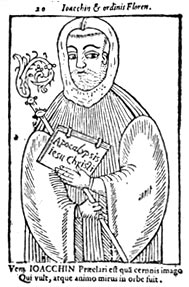
Joachim of Fiore, also known as Joachim of Flora, was an Italian Christian theologian, Catholic abbot, and the founder of the monastic order of San Giovanni in Fiore. According to theologian Bernard McGinn, "Joachim of Fiore is the most important apocalyptic thinker of the whole medieval period." The Divine Comedy of Dante Alighieri is one of the most famous works possibly inspired by his ideas. Later followers, inspired by his works in Christian eschatology and historicist theories, are called Joachimites. On June 27, 2024, Pope Francis, in his message for the World Day of Creation, described Joachim of Fiore, saying that "Joachim was able to propose the ideal of a new spirit of coexistence among people" and thus marks a turning point in history, as this had not happened in more than eight centuries since the death of the Florensis monk.
The Dulcinians were a religious sect of the Late Middle Ages, originating within the Apostolic Brethren. The Dulcinians, or Dulcinites, and Apostolics were inspired by Franciscan ideals and influenced by the Joachimites, but were considered heretical by the Catholic Church. Their name derives from the movement's leader, Fra Dolcino of Novara, who was burned as a heretic on the orders of Pope Clement V.
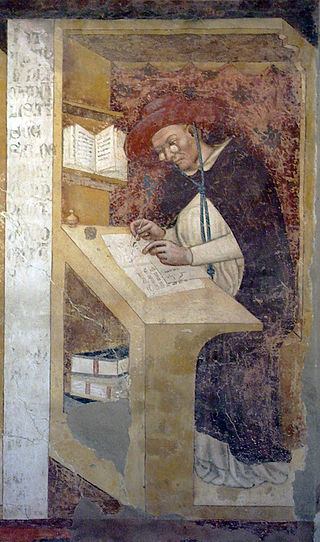
Hugh of Saint-Cher, O.P. was a French Dominican friar who became a cardinal and noted biblical commentator.
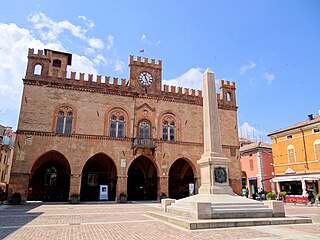
Fidenza is a town and comune (municipality) in the province of Parma, in the Emilia-Romagna region of Italy. It has around 27,000 inhabitants. The town was renamed Fidenza in 1927, recalling its Roman name of Fidentia; before, it was called Borgo San Donnino.

Salimbene di Adam, O.F.M., was an Italian Franciscan friar, theologian, and chronicler. Salimbene was one of the most celebrated Franciscan chroniclers of the High Middle Ages. His Cronica is a fundamental source for Italian history of the 13th century.

The Joachimites, also known as Joachites, a millenarian group, arose from the Franciscans in the thirteenth century. They based their ideas on the prior works of Joachim of Fiore, though rejecting the Church of their day more strongly than he had. Joachimite beliefs were condemned by the Fourth Council of the Lateran and Joachimite interpretations became popular during the Protestant Reformation, and even influenced some Protestant interpretations. He also divided history into three ages: the ages of the Father, the Son, and the Holy Spirit.

Saint Domninus of Fidenza is an Italian Catholic saint. According to tradition, he died in 304 AD and was a native of Parma. The cathedral in Fidenza is dedicated to him. The Hieronymian Martyrology commemorates Domninus, but does not include any further information about him, and his feast day is cited as occurring on 9 October. He is not commemorated in the martyrologies of Bede, Ado, Notker, or the Parvum Romanum.

The Diocese of Fidenza is a Latin diocese of the Catholic Church in the Province of Parma, Italy. It was until 1927 named the Diocese of Borgo San Donnino. It is now a suffragan of the Metropolitan Archdiocese of Modena-Nonantola, though historically it was long subject to the Archdiocese of Bologna.

The Cult of the Holy Spirit, also known as the Cult of the Empire of the Holy Spirit, is a religious sub-culture, inspired by Christian millenarian mystics, associated with Azorean Catholic identity, consisting of iconography, architecture, and religious practices that have continued in many communities of the archipelago as well as the broader Portuguese diaspora. Beyond the Azores, the Cult of the Holy Spirit is alive in parts of Brazil and pockets of Portuguese settlers in North America. The Cult of the Holy Spirit involves traditional rituals and religious celebrations of these faith communities.
Bonaventura Claverio (1606–1671) was a Roman Catholic prelate who served as Bishop of Potenza (1646–1671).
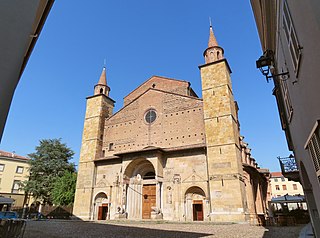
Fidenza Cathedral is a Roman Catholic cathedral in the center of the town of Fidenza, province of Parma, region of Emilia Romagna, Italy. It is the episcopal seat of the Diocese of Fidenza, known until 1927 as the Diocese of Borgo San Donnino. The lower facade retains its original Romanesque sculptural decoration
Ranuccio Scotti Douglas or Ranuzio Scotti Douglas was a Roman Catholic prelate who served as Bishop of Borgo San Donnino (1627–1650), Apostolic Nuncio to Switzerland (1630-1639), and Apostolic Nuncio to France (1639–1641).
Giovanni Battista Aresti de Dovara, O.P. was a Roman Catholic prelate who served as Archbishop of Aleppo (1645–1650).
Giulio Dalla Rosa or Giulio Della Rosa was a Roman Catholic prelate who served as Bishop of Borgo San Donnino from 1698 to 1699.
Stefan Bajic is a professional footballer who plays as a right-back for Serie D Group C club Campodarsego. Born in Italy, he represented both Serbia and Montenegro at youth level.
Antonio Pavonelli, O.F.M. Conv. (1602–1653) was a Roman Catholic prelate who served as Bishop of Venosa (1648–1653).
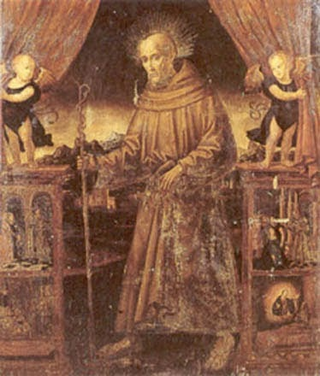
Gerardo Cagnoli was an Italian Roman Catholic and professed religious from the Order of Friars Minor. He embarked on a long pilgrimage south where he passed through Rome and Naples before settling in Trapani and then on the slopes of Mount Etna for a long hermitage. He later entered the Franciscans and served in two of their Sicilian convents where he was known for having caused miracles in addition to his humble and simple childlike nature which people believed was one of the signs of his holiness.
Alessandro Otranto Godano is an Italian professional footballer who plays as a winger for Serie D club Borgo San Donnino.
Gerardo da Sesso was an Italian monk, bishop and cardinal of the Catholic Church.
References
- 1 2 McGinn, Bernard (1998). Visions of the End: Apocalyptic Traditions in the Middle Ages. Columbia University Press. p. 160. ISBN 978-0-231-11257-4.